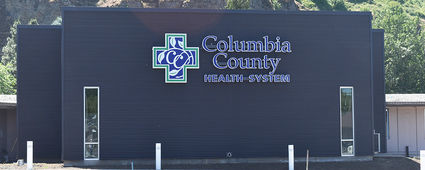COVID-19 stresses on Dayton General Hospital featured in Washington Post
April 2, 2020
DAYTON–The plight of critical-access hospitals-as seen through the "eyes" of Dayton General Hospital–is in the national spotlight thanks to a front-page story which appeared in the Sunday, March 15 Washington Post, underscored by the COVID-19 pandemic.
Post writer Eli Saslow and photographer Nick Otto were in Dayton conducting interviews the moment Columbia County's (so-far) single positive coronavirus test result was received.
Dayton General was the topic of a full-page treatment in the Sunday Post that started on the front page with a photo of Registered Nurse Jen Lingo walking arm-in-arm with a Booker Rest Home resident, and continued inside to a comprehensive piece detailing the urgency of the hospital's situation such as the quantity of personal protective equipment (PPE) in the stock room, and its unavailability due to the pandemic, the challenges one or more COVID-19 patients might create, a brief biography of Emergency Department chief Lewis Neace, and the planning and preparations underway should the worst occur and the hospital finds itself inundated with COVID-19 patients from the community's high percentage of elderly with underlying health issues.

To date, just one positive COVID-19 identification has been made in Columbia County, according to Columbia County Public Health Administrator Martha Lanman. Negative tests of 35 suspected cases have been completed and there are no pending tests.
The local individual contracted COVID-19 on an overseas trip, self-quarantined at home and did not require hospitalization.
Dayton General Hospital (DGH) is prepared as well as able for the anticipated peak of COVID-19 cases, which is expected the third week of April, said Shane McGuire, CEO of the Columbia County Health System.
"I think that everyone has been what 'if-ing' themselves to death," McGuire said this week. "Every day, we're asking 'what am I not thinking about?' and 'What have I missed?'"
At the time the Post writer visited, DGH had two rooms equipped with negative air pressure, an isolation practice which does not allow air to escape a room and circulate in other rooms. McGuire reported that the hospital's construction firm, Leone & Keeble, has provided construction air handlers to expand the number of rooms with negative pressure to eight.
The hospital has been divided into areas of non-isolation and isolation. Some patients are placed in the negative air pressure isolation rooms as a precaution while test results are pending, he said. Test turnaround has shortened dramatically thanks to a lab in the western U.S. taking samples.
"We still have some work to do before the peak happens," McGuire said.
Another challenge is the current stock and availability of PPE such as gloves, face shields and gowns, which McGuire said are in short supply. To mitigate, staff has been using the Telemedicine system to its advantage, meaning PPE disposables can be conserved.
"We're managing well with a current census of zero COVID-19," McGuire said. "But even one would increase the use of PPEs." PPEs are being stockpiled to be doled out to hospitals most in need, he added.
The Post article emphasized the scarcity of medical supplies to protect staff from COVID-19. The hospital has stocks of PPEs but supply manager Chris Davis tells the Post that order after order is rejected, a situation he first noticed in January. Four boxes of the highly sought-after N95 masks, for example, were obtained from Dayton Tractor and City Lumber, the article indicated.
In case an infected patient was admitted, Davis said "we could burn through some of these supplies in days."
Dr. Lewis Neace was profiled for several paragraphs, noting that patients who get very sick would be transferred, but stopping short of answering the question: What if the surrounding trauma centers are full?
During the interview, a nurse delivered a document with the lab results on Dayton's one positive. Dr. Neace scanned the paper, relieved that "not detected" was appearing so many times...until he reached the "COVID-19 Section" and "Detected."
"Oh," Neace said, wincing, setting the paper down on his desk. "Detected.", the Post article read.
The remaining paragraphs of the piece tell about the hospital staff's concern after hearing about the positive test result.
The "good news," according to the article, was that the positive patient had been traveling overseas, was tested in a car and never entered the hospital, Nursing Supervisor Angie Moore was quote as saying to a staff meeting. The person then self-quarantined at home and didn't leave the house.
In the story, the nurses questioned Moore about the many possibilities the virus could have been spread, and then Moore took the nurses through the process of entering the negative-pressure rooms, which at the time numbered two, but now involves eight rooms. Working with the contractor that renovated the hospital, Leone and Keeble, construction air handlers were brought in to create the additional rooms suitable for infection control, McGuire told the Chronicle this week.
Moore took the staff through a "dress rehearsal" from the "cold" regular part of the hospital into the negative-airflow rooms, or "hot," being cautioned to carefully remove the PPE for use when-or if-the coronavirus comes calling.

